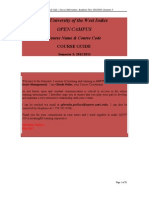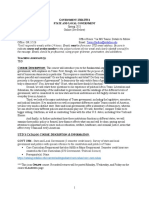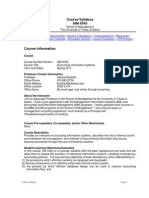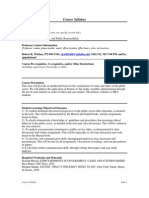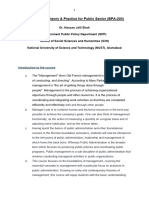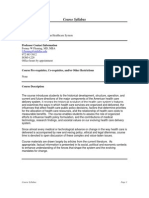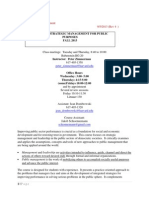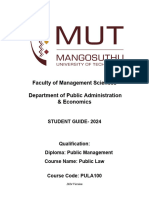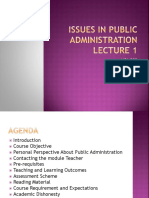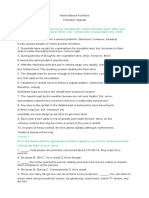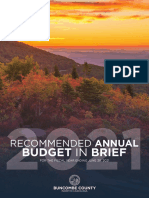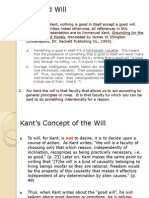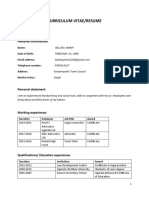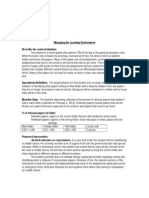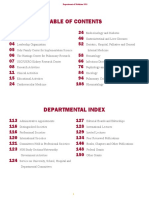Public Management Syllabus
Uploaded by
Tiffany Page CarterPublic Management Syllabus
Uploaded by
Tiffany Page CarterCourse Syllabus
________________________________________________________________
Course Information
Course Number/Section PA 6311 / 5h1
Course Title Public Management
Term SPRING 2023
Days & Times Mondays 7:00 to 9:45 PM CB3 1.308
________________________________________________________________
Contact Information
Professor: John McCaskill, PhD, CPA, CMA
Office: GR 2.204
Email Address: john.mccaskill@utdallas.edu
Office Hours: Mondays 5:00 to 6:30 PM and by appointment. Please send me
an email so we can schedule a time to meet if outside of office hours.
________________________________________________________________
Course Modality and Expectations
Instructional All assignments and the exam will be submitted online.
Mode: Hybrid Additional information regarding this mode is available at:
https://www.utdallas.edu/covid/. In-person class meetings
1/23, 2/13, 2/27, 3/20, & 4/17.
This class uses UTD’s eLearning System to manage the
Course online content. You should log in to your eLearning account
Platform before the first day of class to ensure that you have no
problems accessing the site. Once you are logged in, you
will find links to eLearning student tutorials.
This course has a web-based component and as such, all
work will be submitted online through UTD’s eLearning site,
but we will also meet in person for some classes. The class
format will consists of power point presentations (main
points for each week), discussion boards, concept papers,
Expectations quizzes, and a midterm and final exam. Even if you are
unable to meet face to face, you are responsible for reading
the assigned course material each week so that you can
participate in online discussions successfully. LATE
SUBMISSIONS ARE NOT ACCEPTED (unless there are
extenuating circumstances, and only with proper written
documentation).
Class Participation
Regular class participation is expected regardless of course modality. Students
who fail to participate in class regularly are inviting scholastic difficulty. A portion
of the grade for this course is directly tied to your participation in this class. It also
includes engaging in group or other activities during class that solicit your
Course Syllabus Page 1
feedback on homework assignments, readings, or materials covered in the
lectures (and/or labs). Class participation is documented by faculty. Successful
participation is defined as consistently adhering to University requirements, as
presented in this syllabus. Failure to comply with these University requirements is
a violation of the Student Code of Conduct.
________________________________________________________________
Class Recordings
Students are expected to follow appropriate University policies and maintain the
security of passwords used to access recorded lectures. Unless the Office of
Student AccessAbility has approved the student to record the instruction,
students are expressly prohibited from recording any part of this course.
Recordings may not be published, reproduced, or shared with those not in the
class, or uploaded to other online environments except to implement an
approved Office of Student AccessAbility accommodation. Failure to comply with
these University requirements is a violation of the Student Code of Conduct.
NOTE:
The instructor may provide video lectures for this course. Any recordings will be
available to all students registered for this class as they are intended to
supplement the classroom experience. Students are expected to follow
appropriate University policies and maintain the security of passwords used to
access recorded lectures. Unless the Office of Student AccessAbility has
approved the student to record the instruction, students are expressly prohibited
from recording any part of this course. Recordings may not be published,
reproduced, or shared with those not in the class, or uploaded to other online
environments except to implement an approved Office of Student AccessAbility
accommodation. If the instructor or a UTD school/department/office plans any
other uses for the recordings, consent of the students identifiable in the
recordings is required prior to such use unless an exception is allowed by law.
Failure to comply with these University requirements is a violation of the Student
Code of Conduct.
________________________________________________________________
Class Materials
The instructor may provide class materials that will be made available to all
students registered for this class as they are intended to supplement the
classroom experience. These materials may be downloaded during the course,
however, these materials are for registered students' use only. Classroom
materials may not be reproduced or shared with those not in class, or uploaded
to other online environments except to implement an approved Office of Student
AccessAbility accommodation. Failure to comply with these University
requirements is a violation of the Student Code of Conduct.
________________________________________________________________
Course Syllabus Page 2
Course Pre-requisites, Co-requisites, and/or Other Restrictions
None
________________________________________________________________
Course Description
This course will introduce students to the fundamentals of public management as
a field of academic study. Managing in the public sector entails an understanding
of the interaction between three distinct dimensions—administrative structures
and processes, organizations and their cultures, and the skills and values of
individual managers. Public managers must interact with diverse citizens and
produce results that citizens and their representatives expect from their
government while balancing these concerns within a constitutional scheme of
governance. Another purpose of the course is to show how the challenges of
public management vary across different organizational and policy settings. A
related purpose is to show how public management and policy analysis
frequently intersect and to connect policy design and policy management.
The course is not organized as an introductory survey of various subfields or
specialties of public management, but rather as an examination of its context and
significance. Nevertheless, the course should be helpful as one begins to
become educated about the details of the field; and indeed some of the required
readings provide useful background information about the subject that can be
used in turn in assessing the political context and significance of its operations.
As a result of this course (combined with your own experience and skills), you
should be able to recognize and define public management issues at all levels of
government, to offer insightful analysis of public management issues that you
encounter in practice, and to ask good questions, offer good suggestions, and
make good arguments concerning how such issues might be addressed or
solved. The course materials include conceptual and analytic literature as well as
case materials and examples drawn from a variety of sources. The general idea
is that you should use the conceptual materials to analyze issues raised by the
cases and examples.
________________________________________________________________
Student Learning Objectives/Outcomes
• Advance the understanding and appreciation of the history, study, and
practice of public management
• Examine the constraints on and strategies of public managers in a
democratic society
• Enhance students ability to think analytically about problems of public
management from a multidimensional approach
• Consider the application of these topics in the public and nonprofit sectors
• Engage in discussions to develop a sense of how to apply in practice the
topics and ideas covered in the course.
Course Syllabus Page 3
• Critically evaluate the recent trends, challenges, and opportunities in the
field of public management
• Examine the competing forces shaping the pursuit of values in public
affairs and how this competition shapes public policy.
________________________________________________________________
Required Textbooks and Materials
Hill, Carolyn and Laurence E. Lynn Jr. 2016 (2nd Ed.). Public Management:
Thinking and Acting in Three Dimensions. Washington D.C.: Congressional
Quarterly Press.
In Public Management, authors Carolyn J. Hill and Laurence E. Lynn, Jr. show
that constructing critical analyses and persuasive arguments is the principal tool
for effectively managing in three dimensions. Students learn how to analyze and
explain managerial strategies and decisions, critically assessing real world case
studies and building their own arguments.
Textbook can be ordered through the UTD Bookstore or Off-Campus Books.
In addition, selected journal articles may be assigned at the professor’s
discretion.
Technical Requirements
In addition to a confident level of computer and Internet literacy, certain minimum
technical requirements must be met to enable a successful learning experience.
Please review the important technical requirements on the Getting Started with
eLearning webpage.
Course Access and Navigation
This course can be accessed using your UT Dallas NetID account on the
eLearning website.
Please see the course access and navigation section of the Getting Started with
eLearning webpage for more information.
To become familiar with the eLearning tool, please see the Student eLearning
Tutorials webpage.
UT Dallas provides eLearning technical support 24 hours a day, 7 days a week.
The eLearning Support Center includes a toll-free telephone number for
Course Syllabus Page 4
immediate assistance (1-866-588-3192), email request service, and an online
chat service.
Communication
This course utilizes online tools for interaction and communication. Some
external communication tools such as regular email and a web conferencing tool
may also be used during the semester. For more details, please visit the Student
eLearning Tutorials webpage for video demonstrations on eLearning tools.
Student emails and discussion board messages will be answered within 3
working days under normal circumstances.
Distance Learning Student Resources
Online students have access to resources including the McDermott Library,
Academic Advising, The Office of Student AccessAbility, and many others.
Please see the eLearning Current Students webpage for more information.
Server Unavailability or Other Technical Difficulties
The University is committed to providing a reliable learning management system
to all users. However, in the event of any unexpected server outage or any
unusual technical difficulty which prevents students from completing a time
sensitive assessment activity, the instructor will provide an appropriate
accommodation based on the situation. Students should immediately report any
problems to the instructor and also contact the online eLearning Help Desk. The
instructor and the eLearning Help Desk will work with the student to resolve any
issues at the earliest possible time.
________________________________________________________________
Assignments & Academic Calendar
Week 1: 1/23 – Introduction: In-person Meeting
All students should go to the discussion board under introductions and
post a brief introduction of themselves. Please do not post any personal
addresses or contact information. Just tell us a little bit about yourself such
as what year you are in, your major, your interests, brief working history,
and future career plans (if you have formulated any at this time), and your
interest in taking this class – apart from the fact that it is a required course
and is available both in-person or online. Also, complete the readings
below and answer, why do we need governments? We will also discuss in
class.
Course Syllabus Page 5
Hill and Lynn – Preface to Second Edition and Pages 1-4 (Part 1)
The Enduring Myth that Government Should be Run like a Business – Governing
Magazine
http://www.governing.com/columns/smart-mgmt/col-enduring-myth-government-
should-be-run-like-business.html
Reconceptualization of Government-
https://www.youtube.com/watch?v=wNm4GrmOcUQ
Assessment: Complete your online quiz and self introduction. (This week’s
online work will be due by Friday 1/27.)
Week 2: 1/30 – Public Management’s Three dimensions: Structure, Culture
and Craft
Chapter 1 Hill and Lynn
Kaufman, Herbert. 2001. “Major Players: Bureaucracies in American
Government” Public Administration Review 61(1):18-42
Woodrow Wilson, (1887). “The Study of Administration,” Political Science
Quarterly, 2(2): 197-222
Behn, Robert D. (1998). What Right Do Public Managers Have to Lead?” Public
Administration Review 58(3), 209-224.
Assessment: Complete your online quiz by 1/30. Discussion post due 2/3.
Week 3: 2/6 – Rule of Law
Chapters 2 and 3 Hill and Lynn
Christensen, R. K., Goerdel, H. T., & Nicholson-Crotty, S. (2011). Management,
law, and the pursuit of the public good in public administration. Journal of Public
Administration Research and Theory, 21(suppl 1), i125-i140.
Stillman, Sarah. 2013. Taken. The New Yorker.
Online
John Oliver on Civil Forfeiture
https://www.youtube.com/watch?v=3kEpZWGgJks
Assessment: Complete your online quiz prior to class. Discussion post due
2/10.
Course Syllabus Page 6
Week 4: 2/13 – Structural Dimension: In person meeting
Chapters 4 and 5 Hill and Lynn
Chapters 6 and 7 Hill and Lynn
Assessment: Complete your online quiz prior to class. Discussion post due
2/17.
Week 5: 2/20 – Accountability and Ethics
Cooper, T. L. (2004). Big questions in administrative ethics: A need for focused,
collaborative effort. Public Administration Review, 64(4), 395-407.
Hijal-Moghrabi, I., & Sabharwal, M. (2018). Ethics in American Public
Administration: A Response to a Changing Reality. Public Integrity, 20(5), 1-19.
West, J. P., & Bowman, J. S. (2016). The domestic use of drones: An ethical
analysis of surveillance issues. Public Administration Review, 76(4), 649-659.
The Culture of Ethics that the Public Sector Needs. Governing Magazine:
http://www.governing.com/columns/smart-mgmt/col-culture-ethics-public-sector-
needs.html
Assessment: Complete your online quiz prior to class. Discussion post due
2/24.
Week 6: 2/27 – Cultural Dimension: In-person meeting
Chapters 8 and 9 Hill and Lynn
Bass, B. M., & Avolio, B. J. (1993). Transformational leadership and
organizational culture. Public Administration Quarterly, 112-121.
Moynihan, Donald P. 2012. “A Theory of Culture-Switching: Leadership and Red
Tape during Hurricane Katrina.” Public Administration 90(4): 851-868
Schraeder, M., Tears, R. S., & Jordan, M. H. (2005). Organizational culture in
public sector organizations: Promoting change through training and leading by
example. Leadership & Organization Development Journal, 26(6), 492-502.
Assessment: Complete your online quiz prior to class.
Critique 1 due 3/3
Week 7: 3/6 – Craft Dimension
Chapters 10 and 11 Hill and Lynn
Course Syllabus Page 7
Donna Shalala, “Are Large Public Organizations Manageable?” Public
Administration Review 58, no. 4 (1998): 284-289.
Sergio Fernandez and Hal G. Rainey. 2006. Managing Successful Organizational
Change in the Public Sector. Public Administration Review. 66(2): 168-176.
Van der Voet, J., Groeneveld, S., & Kuipers, B. S. (2014). Talking the talk or
walking the walk? The leadership of planned and emergent change in a public
organization. Journal of Change Management, 14(2), 171-191.
Leadership Myths Debunked: ICMA
https://icma.org/articles/article/career-compass-no-47-leadership-myths-
debunked
Assessment: Complete your online quiz prior to class. Discussion post due
3/10.
Week 8: 3/13 – Spring Break!
Week 9: 3/20 – Diversity in Public Management: In-person meeting
Sabharwal, M., Levine, H., & D’Agostino, M. (2016). A Conceptual Content
Analysis of 75 Years of Diversity Research in Public Administration. Review of
Public Personnel Administration, 0734371X16671368.
Sabharwal, Meghna. 2015 “From Glass Ceiling to Glass Cliff: Women in Senior
Executive
Service.” Journal of Public Administration Research and Theory 25(2) 399-426.
Wilkins, V. M., & Williams, B. N. (2008). Black or blue: Racial profiling and
representative bureaucracy. Public Administration Review, 68(4): 654-664.
Sabharwal, Meghna. 2014. “Moving beyond diversity management:
Organizational inclusion to further performance.” Public Personnel Management
43(2) 197-217
When Building a Diverse Workforce, Hiring Is Just the Start. Governing
Magazine. https://www.governing.com/columns/smart-mgmt/gov-diversity-public-
workforce.html
Assessment: Complete your online quiz prior to class. Discussion post due
3/24.
Week 10: 3/27 – EXAM 1 Due 3/31
Course Syllabus Page 8
Week 11: 4/3 – Public Human Resource Management
Todd Jordan and R. Paul Battaglio, Jr. 2014. “Are We There Yet? The State of
Public Human Resource Management Research,” Public Personnel Management
43(1): 25-57.
Llorens, Jared J., and R. Paul Battaglio, Jr., 2010. “Human Resources
Management in a Changing World: Reassessing Public Human Resources
Management Education.”
Review of Public Personnel Administration 30(1): 112-32.
French, P. Edward, and Doug Goodman. 2012. “An Assessment of the Current
and Future State of Human Resource Management at the Local Government
Level.”
Review of Public Personnel Administration 32(1): 62-74.
Svara, J. H. (2010). The next generation challenge: Incorporating the local
government managers of the future. Journal of Public Affairs Education, 16(3),
361-378.
How OPM will build a federal workforce of the future:
https://www.federaltimes.com/smr/50-years-federal-times/2015/12/07/how-opm-
will-build-a-federal-workforce-of-the-future/
Assessment: Complete your online quiz prior to class. Discussion post due 4/7.
Week 12: 4/10 – Public-Private Partnerships and Contract Management
Bloomfield, P. (2006). The Challenging Business of Long‐Term Public–Private
Partnerships: Reflections on Local Experience. Public Administration
Review, 66(3), 400-411.
Forrer, J., Kee, J. E., Newcomer, K. E., & Boyer, E. (2010). Public–private
partnerships and the public accountability question. Public Administration
Review, 70(3), 475-484.
Brown, Trevor L., Matthew Potoski and David Van Slyke. Managing Public
Service Contracts: Aligning Values, Institutions and Markets. Public
Administration Review 66(3): 323-331.
Van Slyke, David M. 2007. "Agents or Stewards: Using Theory to Understand the
Government-Nonprofit Social Service Contracting Relationship." Journal of Public
Administration Research and Theory 17(2): 157-187
The Pros and Cons of Privatizing Government function – Governing Magazine
Course Syllabus Page 9
http://www.governing.com/topics/mgmt/pros-cons-privatizing-government-
functions.html
Assessment: Complete your online quiz prior to class. Discussion post due
4/14.
Week 13: 4/17 – Public Management and Intergovernmental/Intersectoral
Networks : In-person meeting
McGuire, Michael. 2006.” Collaborative Public Management: Assessing What We
Know and How We Know It.” Public Administration Review 66 (s1):33-43.
Provan, Keith and Robin LeMaire. 2012. “Core Concepts and Key Ideas for
Understanding Public Sector Organizational Networks: Using Research to Inform
Scholarship and Practice.” Public Administration Review 73(5): 638-648.
Milward, H. B., & Provan, K. G. (2006). A manager's guide to choosing and using
collaborative networks (Vol. 8). Washington, DC: IBM Center for the Business of
Government.
Moghrabi, I. H., & Sabharwal, M. (2017). The Role of the Information Society in
Promoting a Better and a More Democratic Governance. Journal of Public
Administration and Governance, 7(4), 132-146.
Assessment: Complete your online quiz prior to class.
Critique 2 due 4/21
Week 14: 4/24 - Public Management in an Era of Big Data
Kim, G. H., Trimi, S., & Chung, J. H. (2014). Big-data applications in the
government sector. Communications of the ACM, 57(3), 78-85.
Desouza, K. C., & Jacob, B. (2017). Big data in the public sector: Lessons for
practitioners and scholars. Administration & Society, 49(7), 1043-1064.
Munné, R. (2016). Big data in the public sector. In New Horizons for a Data-
Driven Economy (pp. 195-208). Springer, Cham.
Helbing, D., Frey, B. S., Gigerenzer, G., Hafen, E., Hagner, M., Hofstetter, Y., &
Zwitter, A. (2019). Will democracy survive big data and artificial intelligence?
In Towards Digital Enlightenment (pp. 73-98). Springer, Cham. (READ PAGES
1-20)
Assessment: Complete your online quiz prior to class. Discussion post due
4/28.
Week 15: 5/1– Multidimensional Public Management
Chapter 12 Hill and Lynn
Course Syllabus Page 10
Thomas, J. C. (2013). Citizen, customer, partner: Rethinking the place of the
public in public management. Public Administration Review, 73(6), 786-796.
IBM Report: Ten Challenges Facing Public Managers.
http://www.businessofgovernment.org/report/ten-challenges-facing-public-
managers
Assessment: Complete your online quiz prior to class.
Weeks 16: 5/1 – Exam 2 Due Thursday, 5/4
Submit exam 2 on eLearning – due 5/4
Note: The instructor reserves the right to make any changes to the
syllabus
________________________________________________________________
Grading Policy
Your final grade will be awarded based on the following scale. Grades for all
assignments and tests will be available in the grade book in eLearning.
• Weekly participation and discussions (10 discussion posts) – 30 points
• 2 critiques– 20 points (10 points each)
• Weekly Quizzes – 10 points
• Exam 1 – 20 points
• Exam 2 – 20 points
Letter Grade Percentage Points
90-100 = A
80-89 = B
70-79 = C
Below C is a fail
________________________________________________________________
Course & Instructor Policies
INTERACTION EXPECTATIONS
This course offers the participants the opportunity to interact asynchronously; this
means that the participants may not be "in" the online classroom at the same
time. Our interactions will take place both in class and on the discussion board
forum. Communication online is through words - we do not hear inflections,
sarcasm, or humor, and we do not have physical cues and gestures to clarify
meaning. Therefore, we must make every effort to phrase our responses and
posts so they will not offend nor alienate our classmates. I expect each of you to
completely think out all your posts, read and reread them thoroughly prior to
posting, and to carefully consider what you are saying and how you are saying it.
At all times show respect and courtesy for your fellow classmates.
Course Syllabus Page 11
INTERACTION WITH INSTRUCTOR
The instructor will communicate with students mainly using the Announcements
and Discussions tools. Students may send personal concerns or questions to the
instructor using the course email tool. The instructor will reply to student emails
or Discussion board messages within 3 working days under normal
circumstances.
REQUIRED SOFTWARE
You must have access to Microsoft Office software (Word, PowerPoint and
Excel) version 2007 or higher. Teachers and UTD students are eligible for
significant discounts on software at the UTD Tech Store. You also must have
Adobe’s Acrobat Reader which is available as a free download.
POLICIES AND PROCEDURES
Make-up exams and late assignments
The dates of exams and other assignments are indicated on the class schedule.
Because you will have a full week or more to complete the exams, you most
likely will not need a make-up. However, in case of extenuating circumstances,
make-up exams will only be given for legitimate reasons and with proper written
documentation. If you fail to take an exam or turn in an assignment without a
reasonable excuse, you will receive a “0” for that portion of the course. THERE
WILL BE NO MAKE-UPS FOR QUIZZES.
INCOMPLETE GRADE POLICY
As per university policy, incomplete grades will be granted only for work
unavoidably missed at the semester’s end and only if 70% of the course work
has been completed. An incomplete grade must be resolved within eight (8)
weeks from the first day of the subsequent long semester. If the required work to
complete the course and to remove the incomplete grade is not submitted by the
specified deadline, the incomplete grade is changed automatically to a grade of
F.
ASSIGNMENTS
DISCUSSION BOARD
We will have conversations both in-person (during class) and on the online
discussion board. To facilitate this, we will divide into three groups. There will be
10 discussion topics posted throughout the course of this semester; the professor
will post one discussion question each week related to the readings. Each group
will post their consolidated response on the week’s discussion board by 11:00
PM Friday evenings. In order to receive full credit for this component of the
course, you will be required to participate with your group to write an original
response to each of the prompts that you discuss during class, over the course of
the semester (minimum of 200 meaningful words each week for the first post).
Course Syllabus Page 12
Direct quotes from the material do not count towards the 200 words. The person
posting the group’s response should rotate each week.
If you are unable to attend class for any reason, you will need to post a
response to each of the three group posts by 11:00 PM Saturday. Each of
your response posts should be a minimum of 100 words in length. This will
count as your participation grade for the week.
This is the most important component of the course – you will learn as
much from your peers as from the materials, if not more. You will learn best
by actively participating in the discussions and reflecting on the readings
by applying it to day-to-day public activities and your experiences.
SEE GRADING REBRIC below and on eLearning
Posts and class discussions will be judged by the following criteria:
1. Did the student read and understand the original post?
2. Did the student attempt to contribute a new thought to the thread?
3. Does the student demonstrate a critical understanding of the topic based on
the readings?
4. Does the student make reference to the readings in the discussions?
5. Is the writing grammatically correct? (Spelling, punctuation, and grammar
count! Quoted material does not count towards the word count).
Discussion Board Rubric and Grading
10 points each week
Your work on the Discussion Board includes regular threaded discussions and
activities. Interaction on the discussion board will be monitored throughout the
week. The group posts are due by 11pm on Friday of each week. You will be
graded on this initial posting with the following rubric:
Course Syllabus Page 13
Initial Posting Rubric: Ideas and Organization (10 points)
Proficient (A) 10
• well-developed (200 words minimum); answers the questions
asked
• provides sample citations for support of opinions
• readily offers new interpretations of discussion material.
• critically analyze the content - your posting should not be
just a summary of the reading
• ideas clearly expressed; be grammatically correct and
proofread for spelling errors. It counts in the real world, so
it counts here too
Basic (B) 8
• Shows evidence of understanding most major concepts;
• will offer an occasional divergent viewpoint or challenge;
• shows some skill in support for opinions.
• Some signs of disorganization with expression; transition
wording may be faulty.
Below average (C) 6
• Has mostly shallow grasp of the material;
• rarely takes a stand on issues;
• offers inadequate levels of support.
• Poor language use garbles much of the message;
• only an occasional idea surfaces clearly;
• expression seems disjointed;
• overuse of the simple sentence and a redundancy with words
and commentary;
• paragraphs often appear unrelated to each other. This student
requires constant prompting for contributions.
Minimal (D) 4
• A minimal posting of material. Shows no significant
understanding of material.
• Does not add to the discussion;
• misses the questions. Language is mostly incoherent. Late work
Unacceptable (F) – failure to submit 0
TOTAL: 10
Course Syllabus Page 14
Responses to Group Posts (if unable to attend class) - 10 points
A response to the postings of each of the three groups are due by 11:00 PM on
Saturday. Each of your posts should be a minimum of 100 words. Your
responses should be logical, reasoned, and well supported. Your responses (all
of them) will be graded together, using the following rubric:
• a minimum of three responses (4 points)
• incorporate quotes from the other postings (2 points)
• be logically reasoned and supported (2 point)
• be grammatically correct and proofread for spelling errors. It counts in the
real world, so it counts here too (2 point)
CRITIQUES (10 points)
You are required to write a 2 page critique on any topics (e.g. Rule of Law or
Structural Dimension or Diversity) in the assigned readings. For example, if you
choose to focus on Rule of Law for one of your critiques, you will write a 2 page
critique on all the readings that were provided for that week. Under the topic of
Rule of Law we have readings (Chapters 2 and 3 from Hill and Lynn; Christensen
et al., 2011; and Stillman). You need to incorporate at least 3 out of the 4
readings of that week and critique about it in a comprehensive manner. I know 2
pages is not much, but this will help with concise writing and focusing on the key
points. Focus on the unifying themes and point out some deficiencies – like you
do in your discussion board.
Please keep in mind that it is not an exercise in summarizing the readings.
Summaries will get a lower grade. Things to focus on:
1. Discuss your thoughts on the readings, including general themes,
disagreements, and any insights you gleam from the readings that can be
applied to current events or your current/past job
2. The review should address the following questions: What were the major
themes? What would you challenge? What are the implications of the
topic for working in public and nonprofit organizations?
3. In keeping with standard protocols, utilize Times New Roman, 12 point
font, and one inch margins. In the header, place the tile “Readings Week
__” with the week number of the readings in the blank. The critiques are
due 3/3 and 4/21.
SEE GRADING RUBRIC below and on eLearning
Course Syllabus Page 15
Rubric - Reading Critique
Levels of Achievement
Criteria Needs Work Proficient Exemplary
1 Point 3 Points 5 Points
Fully Complies Major errors and/or Submission meets the intent Fully responds to assignment
with Instructions omissions in submission. of the instructions with minor instructions.
errors or omissions.
Mechanics of Poor spelling and grammar; Minor errors in spelling and Submissions are grammatically
Writing format is extremely hard grammar, yet overall format is correct with rare misspellings,
to read would be deemed clear. format is easy to read/
as unprofessional professional delivery.
documentation by common
business standards.
Relevance of Question topics which do Questions allow responses Questions related to chosen
Questions not relate to the article; that are short in length and article are insightful and
answers are not backed up offer no further insight into thought provoking; expresses
by a reference; unclear the topic; answers are stately questions in a clear and
connection to article; clearly with occasional lack of concise manner with obvious
minimal expression of connection to topic, and/or connection to topic.
opinions or ideas. provides limited citations for
the community to reference.
Relevance of Answers are not backed up Answers are stately clearly Answers are insightful and
Answers by a reference; unclear with occasional lack of thought provoking; cites at
connection to article; connection to topic, and/or least one but preferably
minimal expression of provides limited citations for several credible references
opinions or ideas. the community to reference. related to topic (text, website,
or other credible / scholarly
references); expresses
answers and ideas in a clear
and concise manner with
obvious connection to topic.
Critical Makes errors in interpreting Accurately interprets article; Interprets article in accurate
Thinking/Analysis article; opinion based uses main points of and insightful ways. Uses
comments only; superficial information from resources/ information thoughtfully, in a
commentary. references; questions do not ways that are factually
provoke significant relevant and accurate;
new thinking or further in- questions and answers show
depth discussion. analysis, might offer
alternatives or creative
viewpoints based on concrete
evidence.
ASSIGNMENT SUBMISSION INSTRUCTIONS
Locate the assignment in your eLearning course. You will submit your
assignments in the required file format with a simple file name and a file
extension. To submit your assignment, click the assignment name link and follow
the on-screen instructions to upload and submit your file(s).
Course Syllabus Page 16
Please Note: Each assignment link will be deactivated after the assignment due
time. After your submission is graded, you may go to My Grades on the course
menu and click the score link to check the results and feedback.
EXAMS
Open book examinations (Exams 1 & 2) are scheduled the week of 3/31 and 5/4.
The format is short-essay style and multiple choice questions. In addition, weekly
quizzes will be posted on eLearning, which will be due prior to class each week.
Quizzes will be multiple choice questions. Each quiz is timed and is graded on a
20 point basis.
ACCESSING GRADES
Students can check their grades by clicking “My Grades” on the course menu
after the grade for each assessment task is released.
________________________________________________________________
Off-campus Instruction and Course Activities
None
________________________________________________________________
Comet Creed
This creed was voted on by the UT Dallas student body in 2014. It is a standard
that Comets choose to live by and encourage others to do the same:
“As a Comet, I pledge honesty, integrity, and service in all that I do.”
________________________________________________________________
Academic Support Resources
The information contained in the following link lists the University’s academic
support resources for all students.
Please see http://go.utdallas.edu/academic-support-resources.
________________________________________________________________
UT Dallas Syllabus Policies and Procedures
The information contained in the following link constitutes the University’s policies
and procedures segment of the course syllabus.
Please go to http://go.utdallas.edu/syllabus-policies for these policies.
The descriptions and timelines contained in this syllabus are subject to change at
the discretion of the Professor.
Course Syllabus Page 17
You might also like
- UT Dallas Syllabus For Pa3333.001.11s Taught by Meghna Sabharwal (mxs095000)No ratings yetUT Dallas Syllabus For Pa3333.001.11s Taught by Meghna Sabharwal (mxs095000)10 pages
- ONLINE - Fall 2020 Public Administration MGMT 243-3No ratings yetONLINE - Fall 2020 Public Administration MGMT 243-310 pages
- Public Service Delivery Course Guide BookNo ratings yetPublic Service Delivery Course Guide Book4 pages
- PA 151 COURSE OUTLINE 1st SEMESTER CLASS VERSIONNo ratings yetPA 151 COURSE OUTLINE 1st SEMESTER CLASS VERSION7 pages
- UT Dallas Syllabus For Pa6345.001.10f Taught by Doug Goodman (dxg101000)No ratings yetUT Dallas Syllabus For Pa6345.001.10f Taught by Doug Goodman (dxg101000)7 pages
- UT Dallas Syllabus For Acct6365.501.11f Taught by Samuel Cheng (sxc109021)No ratings yetUT Dallas Syllabus For Acct6365.501.11f Taught by Samuel Cheng (sxc109021)6 pages
- UT Dallas Syllabus For Acct6334.0g1.11f Taught by Tiffany Bortz (Tabortz)No ratings yetUT Dallas Syllabus For Acct6334.0g1.11f Taught by Tiffany Bortz (Tabortz)9 pages
- MGMT 244 Reforming The Public Sector-Tariq Mahmud-Spring 2021No ratings yetMGMT 244 Reforming The Public Sector-Tariq Mahmud-Spring 20217 pages
- UT Dallas Syllabus For Soc4396.0i1.11s Taught by Euel Elliott (Eelliott, Mpa051000)No ratings yetUT Dallas Syllabus For Soc4396.0i1.11s Taught by Euel Elliott (Eelliott, Mpa051000)9 pages
- Introduction to Public Administration SyllabusNo ratings yetIntroduction to Public Administration Syllabus9 pages
- UT Dallas Syllabus For Aim6343.0g1.11s Taught by Indranil Bardhan (Bardhan)No ratings yetUT Dallas Syllabus For Aim6343.0g1.11s Taught by Indranil Bardhan (Bardhan)11 pages
- UT Dallas Syllabus For Poec7318.501.11f Taught by Robert Whelan (rkw091000)No ratings yetUT Dallas Syllabus For Poec7318.501.11f Taught by Robert Whelan (rkw091000)6 pages
- UT Dallas Syllabus For Govt3310.001 06f Taught by Scott Robinson (Scottr)No ratings yetUT Dallas Syllabus For Govt3310.001 06f Taught by Scott Robinson (Scottr)8 pages
- UT Dallas Syllabus For Psci5303.501.07s Taught by Donald Arbuckle (Dra062000)No ratings yetUT Dallas Syllabus For Psci5303.501.07s Taught by Donald Arbuckle (Dra062000)12 pages
- UT Dallas Syllabus For hmgt6320.501.10f Taught by Forney Fleming III (fwf081000)No ratings yetUT Dallas Syllabus For hmgt6320.501.10f Taught by Forney Fleming III (fwf081000)6 pages
- UT Dallas Syllabus For Ob6326.0g1.11f Taught by Tracey Rockett (Rockettl)No ratings yetUT Dallas Syllabus For Ob6326.0g1.11f Taught by Tracey Rockett (Rockettl)14 pages
- Application To Make "Conservative Political Thought" A Permanent Course at Portland State UniversityNo ratings yetApplication To Make "Conservative Political Thought" A Permanent Course at Portland State University13 pages
- Public Sector Managment Course Outline AHSS 1140 - Section 05 - KILLINGSWORTH - W21No ratings yetPublic Sector Managment Course Outline AHSS 1140 - Section 05 - KILLINGSWORTH - W218 pages
- UT Dallas Syllabus For Aim6334.0g1.11s Taught by Tiffany Bortz (Tabortz)No ratings yetUT Dallas Syllabus For Aim6334.0g1.11s Taught by Tiffany Bortz (Tabortz)9 pages
- UT Dallas Syllabus For Poec6312.001.09s Taught by Sheryl Skaggs (Slskaggs)No ratings yetUT Dallas Syllabus For Poec6312.001.09s Taught by Sheryl Skaggs (Slskaggs)4 pages
- MGMT 244-Reforming The Public Sector-Tariq MahmudNo ratings yetMGMT 244-Reforming The Public Sector-Tariq Mahmud6 pages
- BA 385 Syllabus (Summer 2019) Caitlin Upshaw Portland State University Business EnvironmentNo ratings yetBA 385 Syllabus (Summer 2019) Caitlin Upshaw Portland State University Business Environment8 pages
- UT Dallas Syllabus For Aim6330.0g1.09u Taught by Laurel Franzen (Laurelf)No ratings yetUT Dallas Syllabus For Aim6330.0g1.09u Taught by Laurel Franzen (Laurelf)12 pages
- UT Dallas Syllabus For Pa5319.001.08s Taught by Kathy Lingo (Klingo)No ratings yetUT Dallas Syllabus For Pa5319.001.08s Taught by Kathy Lingo (Klingo)7 pages
- PUB 203 - BALLB, IV Semester - Basics of Public AdministrationNo ratings yetPUB 203 - BALLB, IV Semester - Basics of Public Administration6 pages
- Public Administration - Teaching Plan - July 2022No ratings yetPublic Administration - Teaching Plan - July 20227 pages
- MGMT 243 - Public Administration - Mohsin BashirNo ratings yetMGMT 243 - Public Administration - Mohsin Bashir10 pages
- Eelliott@utdallas - Edu: Online Learning Platform: Top Hat SubscriptionNo ratings yetEelliott@utdallas - Edu: Online Learning Platform: Top Hat Subscription7 pages
- UT Dallas Syllabus For Eco4348.001 05f Taught by Donald Hicks (Dahicks)No ratings yetUT Dallas Syllabus For Eco4348.001 05f Taught by Donald Hicks (Dahicks)7 pages
- (Form2) Personal Statement and Study Plan 2016fallNo ratings yet(Form2) Personal Statement and Study Plan 2016fall5 pages
- Transition Signals Home Based Activities StudentsNo ratings yetTransition Signals Home Based Activities Students3 pages
- Walden University RSCH 8210: Quantitative Reasoning and Analysis Dr. Randy Heinrich September 19, 2021No ratings yetWalden University RSCH 8210: Quantitative Reasoning and Analysis Dr. Randy Heinrich September 19, 20219 pages
- Karnataka Samskrita University: Pampamahakavi Road, Chamarajpet, BangalareNo ratings yetKarnataka Samskrita University: Pampamahakavi Road, Chamarajpet, Bangalare5 pages
- FY2021 Recommended Budget in Brief (Final)No ratings yetFY2021 Recommended Budget in Brief (Final)64 pages
- DLP - Principles of Marketing 2 - 041634No ratings yetDLP - Principles of Marketing 2 - 0416347 pages
- Global Perspectives Project - NUTR14310G Science of Popular Diets - Impact of NutNo ratings yetGlobal Perspectives Project - NUTR14310G Science of Popular Diets - Impact of Nut3 pages
- Classroom Observation Tool: Lesson Plan in ENGLISH 1100% (1)Classroom Observation Tool: Lesson Plan in ENGLISH 13 pages
- Unit 1 Language and Society: 1.0 ObjectivesNo ratings yetUnit 1 Language and Society: 1.0 Objectives12 pages


